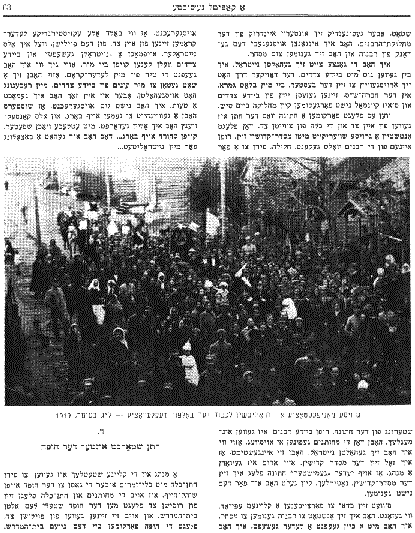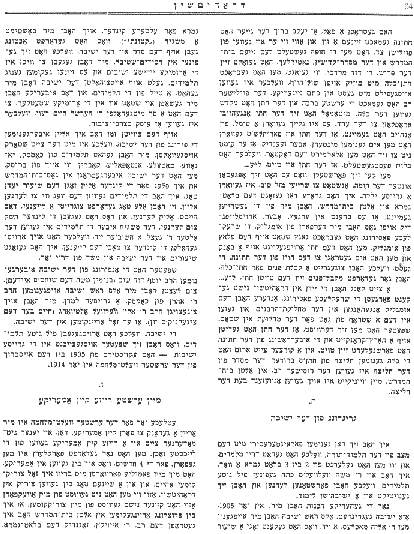Previous Page
|
Next Page
 [
Page 63
]
[
Page 63
]
town, but since I was right in the middle of the rabbinical dispute, I gave up
the idea of being a rabbi, and went into business.
I remained neutral the whole
time, and got along with both sides. This ended up being the best choice, since
there were people from both groups at my Talmud class, and there was never any
dispute during the class.
Whenever there was a wedding
where the groom was from one group and the bride from the other, there was a
problem about which rabbi to choose to officiate. Inviting one of the two
rabbis could lead to confusion at the wedding; inviting both rabbis was
impossible. The two families thus had no way out. Since I was neutral, they
decided to invite me to officiate. So the custom was to invite me to officiate
at any "mixed marriage." However, I didn't take any money to do this.
It's worth describing a small
episode. As mentioned, I decided to go into business instead of the rabbinate,
and had thought up an idea in opening a leather business. I figured that since
members of one group or the other owned the existing leather businesses, mine
would be a "neutral" business, and both sides could shop at my store.
As soon as I opened the doors of my leather store, shoppers from both camps
came by. My plan worked, but I made one mistake. I didn't realize that
shoemakers were used to buying on credit; consequently I myself was forced
several weeks later to buy on credit, and thus ended up paying a price for my
neutrality!
[Photo:] A large demonstration in Drohitchin in honor of the Balfour
Declaration – May 18, 1919.
D.
A groom dies under the wedding canopy
In the small towns there was a custom of accompanying the bride and groom with
music through the streets of town, all the way to the wedding canopy at the
synagogue courtyard. If the two families and the couple were from the
"Russian" side, they set up the canopy next to the Old House of
Study; if they were from the "Polish" side, they set it up at the New
House of Study.
 [
Page 64
]
[
Page 64
]
There was a case where Yaakov
Baruch the Peddler made a wedding for one of his sons, and since he was from
the "Polish" side, they set up the canopy at the New House of Study,
and the officiating rabbi, of course, was the non-chassid, R. David Mordechai.
As mentioned, the couple was accompanied by music to the synagogue courtyard,
which was filled with guests and curiosity-seekers. The Polish rabbi pronounced
the first blessing, and the couple was married. Suddenly, the groom started to
fall to the ground, and confusion erupted. At first people thought that the
groom fainted, and they tried to revive him, but when they realized that he
wasn't regaining consciousness, they rushed to get a doctor, who pronounced the
groom dead.
You can imagine what happened
under the wedding canopy. Instead of shouting
mazel tov,
everyone started crying. At that very moment I was giving my class in the Old
House of Study, and we thought that people were shouting because a fire had
broken out somewhere. When we ran outside, we found out what happened. The
horrible event brought the entire community to the scene of the tragedy. The
groom was laid out on a bench, and he was carried to the house where the
wedding was to take place. The guests, who had prepared a welcome for the
couple prepared instead a funeral for the dead groom.
The Jews of Drohitchin couldn't
forget about the horrible event for a long time. People attributed the tragedy
to the rabbinical dispute, and saw it as a punishment from heaven for the
community dispute. Later they found out that the groom had heart trouble, and
the excitement of the wedding hastened his demise. A short time later, the
bride had to perform the ceremony releasing her from levirate marriage with the
groom's brother [this is required by Jewish law when a childless widow does not
marry her husband's brother, called a levirate marriage]. The Russian rabbi
officiated at the ceremony in the Old House of Study, and I was also present at
the ceremony.
E.
Founding of the Yeshiva
I then became interested in the
situation of the religious elementary school, which had three teachers who
taught 2 to 3 pages of Talmud a week. I found many good students in R. Moshe
Velvel's class who knew how to study Talmud and who needed a yeshiva
environment.
In 1905, after making the
appropriate preparations, we established a yeshiva for older students, and
appointed R. Eliyahu Machles as head of the yeshiva. He knew how to teach
Talmud to older students. We also appointed a yeshiva supervisor who oversaw
the yeshiva study program; the yeshiva held classes in the chassidic synagogue.
We publicized the yeshiva in surrounding Jewish communities, and we recruited a
sufficient number of students. We had enough money to support the yeshiva: the
students' parents paid some, and the rest was collected in town and the nearby
communities. R. Hershel Chaim Lev, who was a community activist, assisted us
considerably.
In the second semester I took
over management of the yeshiva, which over time grew significantly. We had
students from Khomsk, Yanova, Motele, Antapolia, Kobrin as well as Brisk. The
yeshiva classes were moved to House of Study Street, and I taught the children
myself every day, and showed them how to learn the Talmud on their own. They
had to prepare their studies each day and to study on their own. This gave them
a desire to study. The program supervisor was the aged R. Getzel, a
highly-respected person who assisted the children in preparing their studies. I
taught at the yeshiva for three years.
Later, the yeshiva
administration appointed Rabbi Yosef David Shub (Binyamin Moshe the
Slaughterer's son-in-law). Finally, Rabbi Aharon from Khomsk, a great scholar,
joined the yeshiva as its head, and invited Rabbi Eliyahu Velvel Altvarg
(Chaim Ber, the bricklayer's son) to teach at the yeshiva.
The yeshiva, which had good
students who later excelled in the large yeshivas existed from 1905 until the
outbreak of World War I in 1914.
F.
My first trip to America
A few years before World War I,
I had the idea to go to the United States. In those early days, a trip to
America was easy. All you had to do was think about it, and you went. During
the 4 months I was in the United States, my family wrote me begging me to
return home. So one day I just appeared back in Drohitchin. Since people didn't
know I left, they also didn't know I had returned. When I went to the Old House
of Study, I found the rabbi, R. Isaac, teaching a page of Talmud.
Previous Page
|
Next Page
This material is made available by JewishGen, Inc.
and the Yizkor Book Project for the purpose of
fulfilling our
mission of disseminating information about the Holocaust and
destroyed Jewish communities.
This material may not be copied,
sold or bartered without JewishGen, Inc.'s permission. Rights may be
reserved by the copyright holder.
JewishGen, Inc. makes no representations regarding the accuracy of
the translation. The reader may wish to refer to the original material
for verification.
JewishGen is not responsible for inaccuracies or omissions in the original work and cannot rewrite or edit the text to correct inaccuracies and/or omissions.
Our mission is to produce a translation of the original work and we cannot verify the accuracy of statements or alter facts cited.
 Drogichin, Belarus
Drogichin, Belarus
 Yizkor Book Project
Yizkor Book Project
 JewishGen Home Page
JewishGen Home Page
Yizkor Book Director, Lance Ackerfeld
This web page created by Lance Ackerfeld
Copyright © 1999-2025 by JewishGen, Inc.
Updated 10 Dec 2001 by LA
 [
Page 63
]
[
Page 63
]



